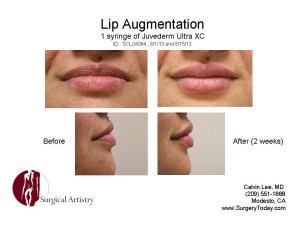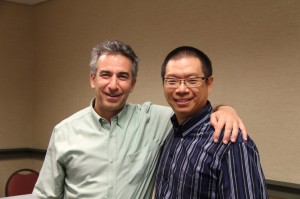To start with, how about a picture of these cannulas?
Why the need for Cannulas in comsetic filler injections?
You might say that Juvederm, Restylane, Radiesse, Belotero, Perlane, Prevelle injections have been just fine with a plain needle. But why increase the difficulty of the procedure? The reason? Less bruising? Smoother results? Safer? Those are excellent reasons for having your injector / surgeon work harder.
What are cosmetic fillers?
Fillers are like they sound – they fill spaces up to replace volume that we’ve lost as we’ve aged. Familiar fillers are Juvederm, Restylane, Perlane, and Radiesse. There are many more brands of cosmetic injectible filler implants. However these are some of the common ones used in my Modesto office: Surgical Artistry. Botox isn’t a filler – Botox relaxes muscles. Here’s a link to my page: Anatomy for Botox. Both fillers and Botox are used for facial rejuvenation.
Why the opening on the side of a cannula?
The opening is on the side for extrusion of the filler such as Juvederm so that the tip can be made in a blunt fashion. If the opening was at the tip, there would be sharp ends. Thus the opening is on the side. Is this good or bad? It’s both. It’s good because now the tip can be blunt. It’s bad because we lose a bit of the precision which we were used to with the tip of a regular needle.
Why the blunt tip on the cannula?
This is the key ingredient for safety and less bruising. Because the tip is blunt, it won’t easily go through vital structures such as arteries, veins and nerves. It glides through fat. In fact this blunt tip cannula idea is used in surgical liposuction. The safety is in the prevention of cutting vital structures. The less bruising is because there’s less internal bleeding due to the cutting of blood vessels.
Cannulas increase the difficulty of the cosmetic filler procedure
Yes, the difficulty is increased and it feels more like a complex procedure. However, the risks diminish and many of the positive results increase – including patient satisfaction, smoother results, and less downtime. I think this is worth the increased time and complexity – something surgeons think about all the time.
Where can cannulas be used?
For most injections where the fillers are introduced below the dermis of the skin. This is a plane where the cannula can glide. Superficial lines – probably a difficult space for the cannula – I would most likely continue to use a needle in the superficial plane. Examples of places for cannula use:
- Nasolabial folds
- Marionette lines
- Cheeks
- Pre auricular area
- Zygoma area.
- Tear troughs
- Orbital hollows
- Lateral Eye Brow fat pad area – helps to raise the eye brows too.
- Temples
- Back of the hands
- Lip Augmentation with fillers – my thoughts on lip augmentation
Why are cannulas more difficult?
- It takes longer to do the procedure
- There’s a need to use a pilot needle (which can still cause a bruise) to create the opening in the skin for the cannulas to slide through.
- Cannulas are flexible and there can be physical hang ups (getting stuck), and difficulty driving the cannulas from a distance (longer needle). And because they are flexible, sometimes they are harder to feel their presence under the skin.
- The hole is on the side of the needle not in the front.
- Sometimes it’s difficult to gauge the depth of the injection
What’s the main reward for using a cannula?
Patient safety. When a blunt tipped cannula is used well by an experienced injector, there is much higher patient safety. Using needles – one could puncture subcutaneous structures which would otherwise like to stay unpunctured.
What are other great benefits of using cannulas?
- Patient safety (mentioned above as the #1 benefit)
- Tip is blunt – actually might hurt less.
- Tip is blunt – won’t injure as much under the skin such as blood vessels and nerves.
- Less bruising – because there’s fewer injury to blood vessels and thus less internal bleeding.
- Less swelling – for reason above.
- Faster recovery.
- Flexible cannula – allows for safety – the cannula moves or wiggles around some of the stiffer structures within the fatty tissue planes.
- Longer length – thus fewer skin puncture sites.
- There’s also the benefit of calling this instrument a cannula rather than a needle – less scary sounding.
What is my favorite cannula?
Cannulas come in many different styles and lengths. I currently use Magic Needle and Dermasculpt cannulas. I haven’t had the chance to try other cannulas on the market. I believe they would be excellent. The Magic Needle cannuals are more flexible – perhaps a little bit too flexible for my current tastes. I know my tastes will change with time – it has before – I remain flexible myself in my choices of cannulas. As for favorite size/length of cannulas. I like the 27g 1.5 inch cannulas for most of my Juvederm injecting. I use this cannula mostly for temples and cheek augmentation.
Do I think that cannulas are game changers in the world of injectable fillers?
I think so. For the sake of patient safety and smoother appearances. Plus with the added benefits of shorter recovery period (less bruising, less swelling).
Do I use cannulas instead of needles for everything
No. There’s a role for each tool.
Disclaimer
These are my thoughts (Calvin Lee). No specific medical information here.








